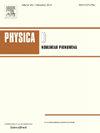The competition between wave turbulence and coherent structures
IF 2.9
3区 数学
Q1 MATHEMATICS, APPLIED
引用次数: 0
Abstract
Wave turbulence of weakly nonlinear dispersive waves is a disordered state in which energy or other conserved quantities are transferred from sources in wavenumber space (the driving range) to sinks (the dissipation range). The theory of wave turbulence provides an analytic derivation of all statistical quantities (most notably the Kolmogorov–Zakharov spectrum) from the underlying equations of motion. A competing and radically different turbulent process with a significant impact on the statistical properties is the formation of coherent structures. Under what conditions can we observe purely weak wave turbulence, and when is it superseded by coherent structures? We study this problem for an influential model of one-dimensional turbulent dynamics, the Majda–McLaughlin–Tabak equation. The formation of narrow radiating solitary waves (pulses) leads to spectra that are steeper than the Kolmogorov–Zakharov spectra. However, for sufficiently large box sizes, we find that wave turbulence prevails within a broad range of four orders of magnitude of the driving force.
波浪湍流与相干结构之间的竞争
弱非线性色散波的波动湍流是一种能量或其他守恒量从波数空间中的源(驱动范围)转移到汇(耗散范围)的无序状态。波浪湍流理论提供了从基本运动方程推导出所有统计量(最显著的是Kolmogorov-Zakharov谱)的解析推导。一个对统计性质有重大影响的竞争和根本不同的湍流过程是相干结构的形成。在什么条件下我们可以观察到纯粹的弱波湍流,什么时候它被相干结构所取代?我们研究了一个有影响的一维湍流动力学模型,Majda-McLaughlin-Tabak方程。窄辐射孤立波(脉冲)的形成导致谱比柯尔莫哥洛夫-扎哈罗夫谱更陡峭。然而,对于足够大的箱形尺寸,我们发现波浪湍流在驱动力的四个数量级的广泛范围内盛行。
本文章由计算机程序翻译,如有差异,请以英文原文为准。
求助全文
约1分钟内获得全文
求助全文
来源期刊

Physica D: Nonlinear Phenomena
物理-物理:数学物理
CiteScore
7.30
自引率
7.50%
发文量
213
审稿时长
65 days
期刊介绍:
Physica D (Nonlinear Phenomena) publishes research and review articles reporting on experimental and theoretical works, techniques and ideas that advance the understanding of nonlinear phenomena. Topics encompass wave motion in physical, chemical and biological systems; physical or biological phenomena governed by nonlinear field equations, including hydrodynamics and turbulence; pattern formation and cooperative phenomena; instability, bifurcations, chaos, and space-time disorder; integrable/Hamiltonian systems; asymptotic analysis and, more generally, mathematical methods for nonlinear systems.
 求助内容:
求助内容: 应助结果提醒方式:
应助结果提醒方式:


